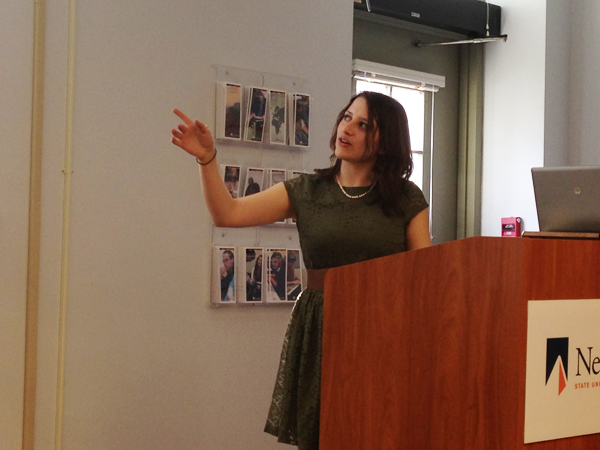
If there is one thing humans from 25,000 years ago have in common with the humans of today, it’s their obsession with the grotesque.
Communications Professor Jerry Persaud and Sasha Ribowsky, a third-year digital media production and French double major, explored this concept in their presentation “The Body Grotesque: From Early Art to Digital Media” held in the Honors Center on Monday, April 8 at 5 p.m.
Prior to the event, Persaud and Ribowsky used their Facebook event page to pose the question: “How are we to understand representations of the Grotesque in Western culture?” They went on to say, “locating the trope of the Grotesque in literature, art, photography, mass media and popular culture will allow us to move between genres in order to demonstrate possible answers to this question.”
Ribowsky began the presentation by giving the “Oxford English Dictionary” definition of “grotesque” and then posed the question her presentation revolved around.
“Grotesque means a work of art in the style, figure or designs characterized by a comic distortion or exaggeration,” Ribowsky said. “If the proportions aren’t accurate, why are they still depicted in art and media? In order to understand the human it is essential to look at the portrayal of the body through history.”
Ribowsky showed photos of the 25,000-year-old Venus of Willendorf statue first discovered in northeastern Austria. Found in 22,000 BCE, the statue depicted a distorted woman with exaggerated breasts, thighs and stomach “laden with fat.”
Ribowsky said the statues, symbolic of the human obsession with fertility, were found in many other places around the world including Russia, France and Italy.
Moving forward through historical evidence, Ribowsky spoke about her analysis of Greek art.
“In Greek art, originally the intent was to create the most realistic image possible,” Ribowsky said. “The Egyptians attempted and came close to reaching the most realistic depictions, but the Greeks were the first to be successful. Once they achieved the goal and created sculptures with exact human dimensions such as the Kritios Boy circa 480 BCE, it became banal.”
Ribowsky’s contemporary examples of the Grotesque body image included Valeria Lukyanova, known as the “Real Life Barbie Doll,” and French performance artist Orlan, who “performs cosmetic surgery with the purpose of distortion as opposed to enhancement as a way to show different ideals.”
Drawing connections from Ribowsky’s introduction, Persaud related the Venus of Willendorf to the 19th-century European obsession with Sarah Baartman, also known as the “Hottentot Venus,” an African woman taken to Europe to be ogled and publicly ridiculed for her large bust, buttocks and other bodily features.
Persaud also related the subject to his research of musical artists today, such as Beyoncé and Nicki Minaj, who are idolized and lauded for parts of their bodies.
“I think that it’s a wonderful thing for students to learn how to take very abstract concepts and make sense of things around them, including themselves, and that includes words, conversations, images and billboards and everything in culture,”
Persaud said.
Persaud had already planned on giving a presentation on a related topic at the Honors Center, but when Ribowsky mentioned she had a related piece published in the university’s 2011 “New Voices, New Visions” book, he said he would love to have her present alongside him.
“I rarely do that with students, but you have to be very, very dedicated and I have not seen dedication like this in a very long time,” Persaud said.
With about 30 attendees, Ribowsky said she was pleased with the presentation because she got the chance to add on research she had done since the initial publication and new information in the media. Persaud even added a video segment from the “Katie Couric Show” that had aired the day before about women who were dangerously obsessed with cosmetic surgery.
“I think it [the presentation] was really successful, especially with the faculty participation in the discussion portion,” Ribowsky said. “I expect to keep building upon our research and hopefully present with Persaud again in the future.”

